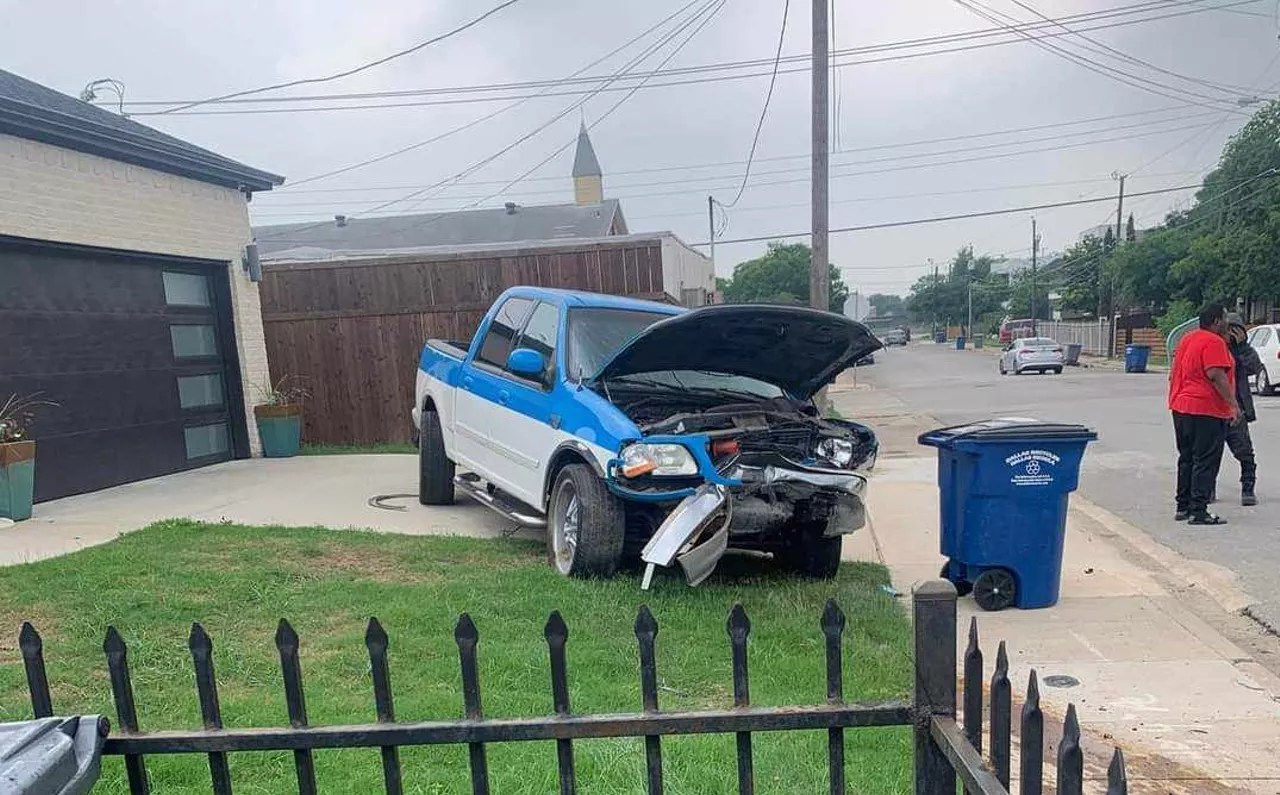
Karen Quiroga

Audio By Carbonatix
In November 2021, Karen Quiroga was returning to the West Dallas home she shares with her partner when she saw metal and plastic strewn about the street.
“It looked like pieces of a car, and we saw a car bumper right outside of our driveway,” she said. “And I looked to where we had our other vehicle parked, which was right in front of … our mailbox, and the corner of it had been hit.”
Quiroga lives near the intersection of Dennison and Puget streets, where cars often speed and do doughnuts. There is a stop sign there, she said, but “everybody blows right through it.”
Over the next several months, Quiroga’s partner worked on the damaged truck to try to get it back up and running. But a speeding car in June turned those plans upside down.
We’re thankful for you. Are you thankful for us?
We feel thankful for our staff and for the privilege of fulfilling our mission to be an unparalleled source of information and insight in Dallas. We’re aiming to raise $30,000 by December 31, so we can continue covering what matters most to this community.
Help us continue giving back to Dallas.
“He was sitting at home and heard a loud crash, and there it goes again,” Quiroga said. “This time, though, they hit it so hard that it pushed it all the way up the yard and the driveway of my neighbor’s house.”
The latest crash prompted Quiroga to ask the Reform Dallas group on Facebook for help in requesting traffic calming measures. She’d like to see speed humps installed on her street, which she described as being pretty wide.
There’s evidence that broad roads enable cars to push faster speeds. One 2016 study of uncongested freeways in Dallas, San Antonio and Houston suggested that drivers go an average of 2.2 mph faster when traveling in 12-foot lanes versus 11-foot ones.
Seeing the responses to her Facebook post was “kind of disheartening” to Quiroga. Some folks pointed out that the price of speed cushion installation may fall on the neighborhood, while others reported that their own request hadn’t been filled.
“It definitely slowed me down,” Quiroga said of the responses. “I feel like my neighborhood is already the kind of neighborhood where we don’t really get much help, so it was just kind of heartbreaking.”
There are several steps residents need to take to make a speed-control request to Dallas 311, which can be done via the app or by phone or website, said Auro Majumdar, assistant director of the city’s Department of Transportation. A traffic safety engineer will first check out the location to determine “which of the 3 Es is most appropriate – engineering, education, and/or enforcement.”
The engineer may then call for adjustments to street-signal timing or request signs, he said. Roads within neighborhoods are usually better contenders for speed cushions and other engineering solutions.
“It’s not easy but it can be done.” – Rudy Karimi, Dallas Park and Recreation Board
“If a street is eligible, the resident must get a petition signed by two-thirds of the neighbors in the affected area,” Majumdar continued in an email. “Once the petition is accepted, engineers collect speed and traffic volume data to determine if a speed cushion is the best solution. If it’s determined a speed cushion (or some other traffic calming measure) is the best solution, it can proceed as funding is available.”
But not all roads would be eligible, like major streets with multiple lanes, greater traffic or bus routes, he added. The department would instead submit traffic enforcement requests to local police.
And streets deemed public safety emergency routes can’t have road humps, which can hinder response times for firetrucks and other first-responder vehicles.
Dallas Park and Recreation Board member Rudy Karimi commented on Quiroga’s post with step-by-step instructions for requesting speed cushions:
“Step 1: open a service request on Dallas 311, traffic -> speed control
Step 2: send the SR to your council member with a letter from your neighborhood association, a signed petition from the neighbors on the street and any other relevant group
Step 3: follow up like crazy
A good council member will get it done, but it will take some time. I got 10 speed cushions on three streets in east Dallas for zero cost. It’s not easy but it can be done. Good luck.”
Residents elsewhere in Dallas have mulled seeking similar traffic-calming changes, including in the Winnetka Heights historic district. A recent study there suggested that a traffic island demonstration had led to lowered average speeds – from 25 mph to 23 mph – and a smaller percentage of speeders.
Other Dallas residents have dealt with speeding drivers slamming cars into homes, including on Harvest Hill Road. CBS Texas reported last August that a truck launched into the front room of a house, where an elderly woman had been sitting some 15 minutes earlier. Over the past decade, no fewer than 11 vehicles have reportedly struck parked cars or homes in that neighborhood.
Back in 2014, a Grand Prairie woman said she’d endured “several close calls due to careless drivers” on her street, NBC-DFW reported at the time. But the installation of road humps apparently ushered in positive changes: The average speed plummeted by more than 10 mph and there were around 400 fewer vehicles each day.
“I walk 10 miles a day, I run around here, and I feel more safe without cars zooming past me,” the resident said, according to NBC-DFW.